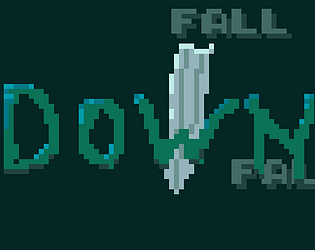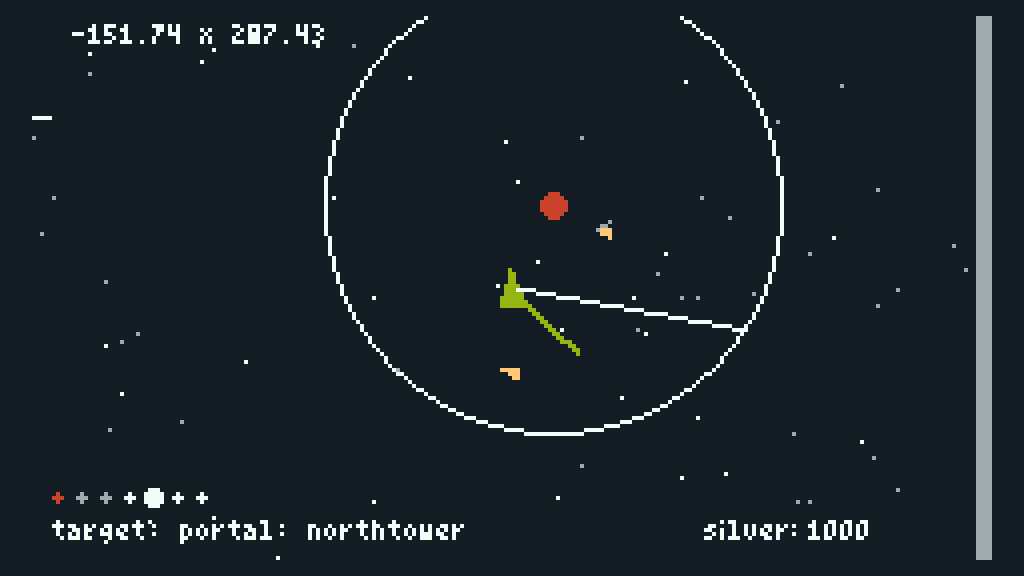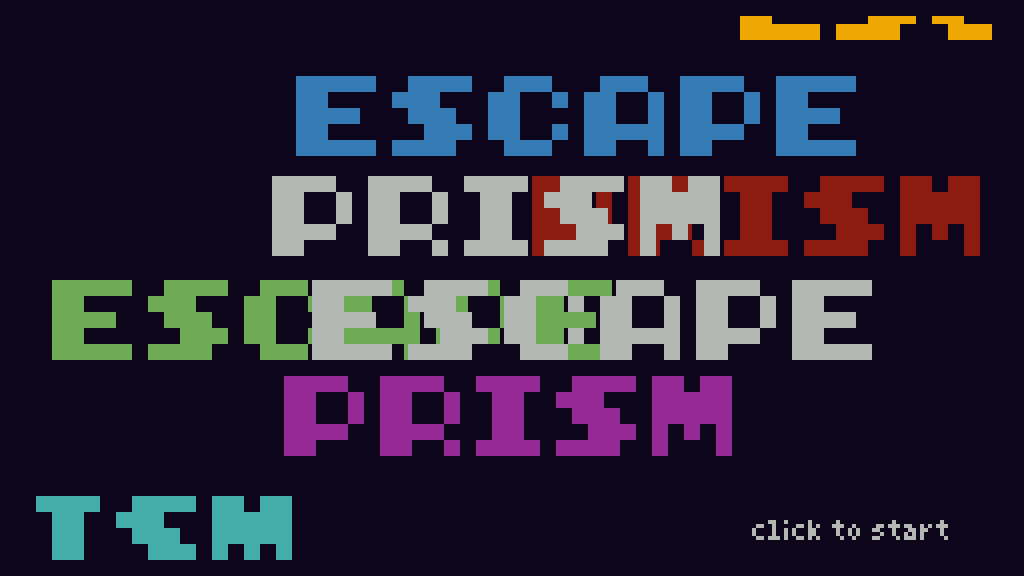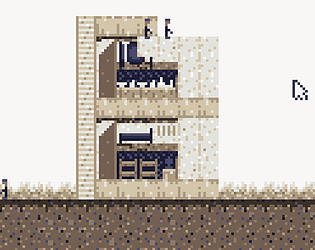heh, thanks; the music for this one is generated; it’s a pretty simple method but allows for a lot of variability within its form. I think the code for it is pretty clever.
mattly
Creator of
Recent community posts
Do you know if this works with OpenJDK? When I run it on macOS, it launches and music plays, but I cannot get past the title screen and "play" button. The following appeared in my terminal:
❯ java -jar -XstartOnFirstThread web-development_macos.jar WARNING: A restricted method in java.lang.System has been called WARNING: java.lang.System::load has been called by org.lwjgl.system.Library$$Lambda/0x00001f80012b9de8 in an unnamed module (file:/Users/mattly/Downloads/web-development_macos.jar) WARNING: Use --enable-native-access=ALL-UNNAMED to avoid a warning for callers in this module WARNING: Restricted methods will be blocked in a future release unless native access is enabled WARNING: A terminally deprecated method in sun.misc.Unsafe has been called WARNING: sun.misc.Unsafe::objectFieldOffset has been called by org.lwjgl.system.MemoryUtil (file:/Users/mattly/Downloads/web-development_macos.jar) WARNING: Please consider reporting this to the maintainers of class org.lwjgl.system.MemoryUtil WARNING: sun.misc.Unsafe::objectFieldOffset will be removed in a future release Loading :music from: resources/audio/music/catching-flies.ogg Loading :step-1 from: resources/audio/sfx/step-1.ogg Loading :step-2 from: resources/audio/sfx/step-2.ogg Loading :step-3 from: resources/audio/sfx/step-3.ogg Loading :step-4 from: resources/audio/sfx/step-4.ogg Loading :step-5 from: resources/audio/sfx/step-5.ogg Loading :web-title-spritesheet from: resources/img/web-title-spritesheet.png Loading :fly-spritesheet from: resources/img/fly-spritesheet.png
thanks, and yeah I get that this is still a work in progress for some things :)
My request for a horizontal layout in the plugin comes from a window management perspective; I don't *always* want MiniMeters to be on top; instead only when the DAW is in the foreground. I can't do that with the app (well, maybe with some creative KeyboardMaestro macros), but I *can* do that with the plugin because plugin windows are only visible when my DAW is in the foreground.
The other side of this is that, when idle, the MiniMeters app uses about 20-25% CPU, while as a plugin the CPU use is managed and it doesn't use anything. I've got a lot of cores so this isn't *too much* of an issue, but it did cause my fan to turn on for the first time in a while.
So I'm too late to give you an answer for this jam, but for the future:
I can't speak to the technicality of the rules, but I think covering a copyrighted piece of music would be in violation of the spirit of them, at least. Public Domain or CC-licensed music, on the other hand, no problem.
There's some great classical stuff in the public domain. Disasterpiece used Chopin's Prelude, Op 28 no 4 (aka "Suffocation") to great effect for the ending of Fez. He even admitted in an interview to just finding a midi file online and orchestrating it with synths. Chopin in particular has I think a bunch of short pieces that would work well for video game music, especially among the Preludes collection.
Something to think about for the next jam.
I'm having trouble getting it to run on macOS/Apple Silicon; the .app bundle will launch, but no windows are created. I can select "About Pizza Express" and get the Löve 2D about dialog (v 11.4a), but nothing else.
So I tried downloading the .love file and running that and I basically got the same thing; I've got 11.5a installed.
Any ideas?
I wish there was more focus on exploration over trading goods,
yeah this is sort of my thing, but I think making that sort of gameplay satisfying either requires some very sophisticated procgen techniques, or a lot of worldbuilding work. Exploring is one of my favorite aspects of both open world games and metroidvanias, and I'd love to make a game centered around that sometime.
The art style and music are awesome
My only gripe is ... lack of audio-visual changes
thanks! the three looping tracks (title, company systems, empire systems) came together pretty quickly, and I wanted to do more for both the music and graphics but I had a lot of life stuff going on during the jam's run and was only available for like half the time.
I gave up on manual flying when holding X felt much more responsive, even with the upgraded engine.
yeah, I could not for the life of me get the hang of manual piloting, which is why there is an autopilot.
If you do have the time, I'd love to hear both of y'all's thoughts on tic80 vs pico8
I have no experience with pico8 – the three game jams I've done with Phil are my first real game dev experiences since playing with Qbasic in high school in the early 90s. In addition to seconding Phil's assessment of the fonts, looking at it's art/music stuff I will say:
- the ability to customize colors on the TIC80 is great – in addition to just being able to make better static palettes, you can dynamically change the palette either through the Pro version's bank swapping, or direct memory manipulation through `poke`.
- the sfx editor is different, but as someone who is very experienced with synthesizer programming, TIC's sfx system strikes me as offering a lot more possibilities. I could be wrong, and I'm sure someone intimately familiar with pico's system could do some amazing things with it. Would I have made TIC's sfx system differently? yes. Would I still like to embed it in a DAW plugin? yes.
- pico's tracker looks very cramped in comparison. I'm not a big fan of trackers; I sketched out all three tunes in a more sophisticated music-making program and then copied that over to the tracker (see the picture below), but as frustrating as I found TIC's tracker to work with (need to nullify a row? you have to kill it with delete/backspace, and then insert a new one with ... the INSERT key. seriously. it's 2025. Who has an insert key on their keyboard? I added one to my QMK keyboard (which tic has further problems with) and used Karabiner Elements to add one to my Mac laptop's keyboard). Anyway after watching a few youtube videos of PICO8's tracker I'm pretty sure I would have given up in frustration.
screenshot of the sketch for the empire system music; each "clip" is labelled with the tic pattern number

tic80 seems like it could make progress for a short jam a more rewarding experience
I like TIC80 for these jams because it keeps us focused. We talked about doing this in Löve2D instead, but I'm not familiar with that yet, and I feel like the increased freedom would have helped us lose sight of trying to make an interesting _game_ in the short time we had.
Hey all,
This was my first game jam. I worked with @technomancy / Phil on Tower Institute of Linguistics. It was also the first time I’ve worked seriously on a game since high school, when the three other people who got to take programming classes instead of MS Office ones made an “energizer bunny” endless platforming game in QBasic. I’m not really sure endless platformers were really a thing in the early 90s but we tried. My bread and butter work involves programming, I’ve been an artist my entire life, and have recently started making music.
I’m really lucky to have worked with Phil on this, his experience with past jams, and familiarity with both the TIC 80 and game logic really smoothed out a lot of problems we would have otherwise. In addition to being my first TIC80 project, this was also my first real project in Fennel – I’ve worked in Clojure previously and dabbled in elisp. I mostly stuck to the artwork and music engine, and the confusing iconography of the HUD in Tower is my fault, though I suspect it’ll be something easy to remedy.
Anyway, some things I learned from this:
Embrace Constraints. This is true for all art, and I think it helped a lot here as well. TIC80 has some severe limitations. When Phil was first talking about this idea, I wanted to do the music, because I want to get more into doing music for video games in general, and I’ve heard jams are a good way to get started in that. I just finished putting together an album that plays around a lot with vocal synthesis, and thought it would be fun to take some of those same ideas and perhaps mash it ideas from one of my favorite movie soundtracks, Arrival, a movie also about learning a language.
And then Phil’s like, well, I want to do it in TIC80 and I poked at it a bit and had that hope dashed. Not because of the tracker, but because of the 4-bit wavetable engine. But it got me thinking: What could I make with this? The game doesn’t really have “levels” or “areas”, the game is about building a thing that gets more chaotic and faceted as you go. I thought about some “ambient sound status monitoring” stuff I’ve played with in the past, and ideas from generative modular synthesis I play with now, and instead figured I could make something that evolved to respond to gameplay. The music in Tower is based around two ideas: Euclidean Rhythms and Shift Register Sequences that are quantized to a scale, both of which I’ve toyed around with but never really used seriously.
We talked for a bit and it seemed like an idea worth exploring. I then offered to take on the artwork; I have a degree in visual art and have worked in a variety of media before, but not pixel art. Let me tell you: 16 colors and 8x8 tiles/sprites is a heck of a limitation to work in. We initially talked about making the world grayscale and using color solely to represent the splintering languages of the tower’s workers. I did a lot of sketching in ProCreate and going with the dark blue/brown/beige base colors instead of gray provided more atmosphere. Similarly, texturing instead of flat surface colors also provided a lot of character.
Cut Scope. We came up with a lot of fun ideas for other things you could build on the tower, and other mechanics that might come into play: tool shops to increase the productivity of your workers, rock-processing shops to make building more efficient, food-processing shops to make the food go farther, elevators to make vertical transport quicker, having to widen the tower as it gets taller, some sort of tech tree enabled by building libraries and educating your workers, all of which got cut. Mostly for time, but also for keeping the core gameplay simpler. Build up, provide for your workers. The injury/medic mechanic was a late addition, mostly because we wanted to include health care alongside shelter, food, and education in the “these are the things a society must provide its people in order to succeed” theme of the tower.
Playtesting is the equivalent of Iterative Development. My bread-and-butter work involves developing novel user interfaces to help people to interact with computers for semantically difficult things; there is very little prior art to draw on for a lot of things I’ve built. If there’s anything I’ve learned from this work, it’s “iterate, iterate, iterate”. Get something built to test an idea, figure out what’s off about it, and repeat. It seems like game development involves a lot of similar problems. While there’s prior art to pull from for “build a tower”, there wasn’t much for “you have people who can’t communicate with each other and that’s a problem”.
There were a lot of things about the way the sprites communicated information to the player that improved over the course of playtesting. The HUD in particular was a late addition to the game meant to help understand the needs of your workers, but I was trying to keep it compact because we were still thinking you’d have to expand the tower horizontally as you built up. It went through a few iterations, and ultimately I added the icons to the build menu in a way that I’d hoped would help people correlate icons with shops and with needs; it still IMO needs some work, but it’s much better than where it started.
Mise en place. As someone with ADHD, I hear this from my partner constantly when cooking. It’s French for “putting in place”, which in this context means getting your build pipelines and all the boring technical stuff figured out and easy, so you’re not struggling with that while also trying to build the thing. Thankfully, Phil has a lot of experience with TIC80 and got that all setup, and I think it was a huge help.
Have fun! I think the most important part of this whole experience. I had a blast and plan to do more jams in the future. I played around with a platforming demo in TIC80 after the jam was over and already my brain is planning out a novel metroidvania puzzle game.






